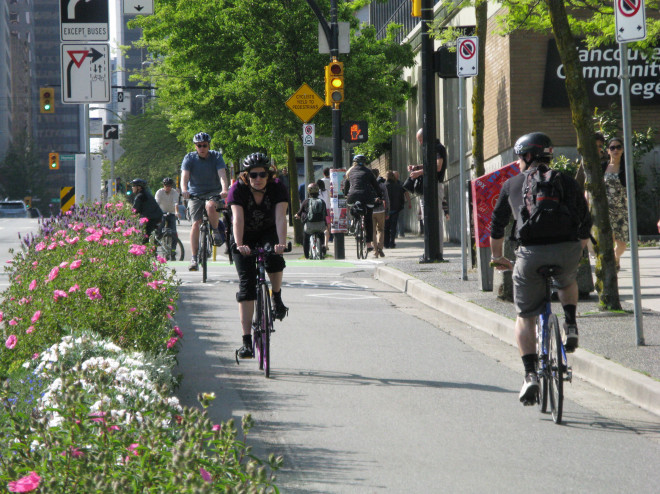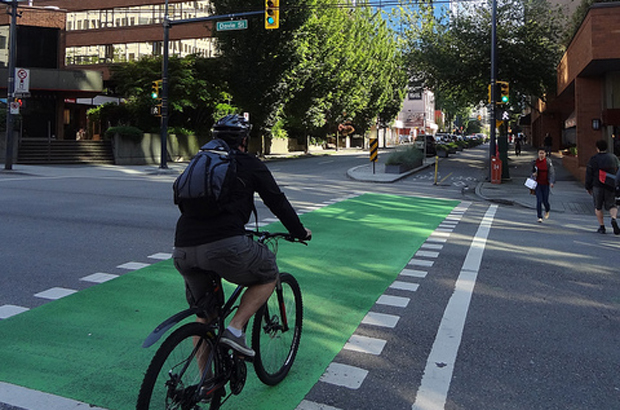
Want Safer Cycling? Think Infrastructure
If you need more evidence that infrastructure saves lives, then look no further. New research from the American Journal of Public Health shows that dedicated bike lanes can cut injuries by half. ECF had a few questions to ask the brains behind the study, Professor Kay Teschke.
Q1. Tell us a little bit about how you conducted your study and some of the main findings.
The study was conducted in two of the largest cities in Canada: Vancouver and Toronto. There were 690 participants. All were injured while cycling, severely enough to be treated at a hospital emergency department. We interviewed the cyclists about their route on the trip when they were injured, then sent trained observers to the injury location and a "control" site randomly selected from the same route. We then classified and compared the route types of the injury and control sites.
"In comparison to those routes, protected bike lanes were the safest."
We compared 14 route types. We made all our comparisons to the most common route type: major city streets without any bike infrastructure and with parked cars. These streets have high motor vehicle traffic volumes and cyclists usually ride between the parked cars and moving cars.
In comparison to those routes, protected bike lanes (also called separated bike lanes or cycle tracks) were the safest, with an estimated relative risk of 0.1 (or a reduction in injury risk of about 90%). Other routes designed for bikes were also safer, with relative risks near 0.5 (or a reduction in injury risk of about 50%): painted bike lanes on major streets without any parked cars; residential street bike routes; and bike paths in parks.
Q2. Your study also says that ‘protected’ bicycle lanes can reduce injuries by 90%. What sort of implications should this have on road design?
"Here, it is sometimes argued that protected bike lanes are less safe than cycling mixed with car traffic, or that cycling culture in North America is different than in Europe, so we shouldn't design routes the way Europeans do."
Yes, protected bike lanes were the safest in the study. This physical separation of cyclists and motor vehicle traffic on major streets is the kind of cycling infrastructure that is common in many northern European cycling countries, but has been extremely rare in North America. Here, it is sometimes argued that protected bike lanes are less safe than cycling mixed with car traffic, or that cycling culture in North America is different than in Europe, so we shouldn't design routes the way Europeans do.
Our results suggest that protected bike lanes are the safest mode of travel alongside major streets, showing that this approach is very effective in North America too.
In addition, we previously did a study of the routes that people prefer to cycle on. We found that people preferred bike-specific routes separated from traffic or with low traffic volumes. The injury study results show that preferred routes are also safe routes, so if safer infrastructure is built, it should both encourage cycling and prevent injuries - a wonderful combination.
Q3 Governments often tend to focus on driver/cyclist education when it comes to reducing cycling fatalities. Can education help improve cyclists’ safety, or is it best to focus on infrastructure?
It is probably very difficult to study whether education reduces cycling injuries, and I am not aware of studies that have done this. But education and route infrastructure do go hand in hand.
In European cycling countries, both receive much more attention than in North America. Certainly, it is vital that cyclists are educated about the differences in risk of different route types, so they can make informed decisions about the routes they choose.
Q4. This study was done in Canada. Do you think that Europe can draw any lessons from your study?
"Our understanding is that there is quite varied infrastructure in European cities, so perhaps these results will help reinforce the use of protected bike lanes..."
Our understanding is that there is quite varied infrastructure in European cities, so perhaps these results will help reinforce the use of protected bike lanes where they are used and promote their installation where they are less common.
New studies in Europe would also help advance our knowledge about cycling safety. There are many designs of protected bike lanes, but our study was not able to distinguish which designs are more or less effective, because there were so few in Vancouver and Toronto at the time. It would be wonderful for the study method to be used in Europe to help understand whether certain designs are safer than others, and especially to examine what intersection treatments are best.
Further Reading
- You can get your hands on a copy of the study here and also read an overview here.
- Atlantic Cities also ran a great story on the study: "Dedicated Bike Lanes Can Cut Cycling Injuries in Half"
- For more great research on cycling, be sure to check out UBC's cycling research program.

About the Interviewee
Kay Teschke is a Professor at the University of British Colombia in the School of Population of Public Health. Dr. Teschke's area of research interest is exposure assessment, and issues addressed by her research span both environmental and occupational health and currently include cycling in cities, impact of transportation infrastructure on ridership and injuries;
Contact the author
Recent news!
Upcoming events
Contact Us
Avenue des Arts, 7-8
Postal address: Rue de la Charité, 22
1210 Brussels, Belgium











